
A gin and tonic is a highball cocktail made with gin and tonic water poured over a large amount of ice. The ratio of gin to tonic varies according to taste, strength of the gin, other drink mixers being added, etc., with most recipes calling for a ratio between 1:1 and 1:3. It is usually garnished with a slice or wedge of lime. To preserve effervescence, the tonic can be poured down a bar spoon. The ice cools the gin, dulling the effect of the alcohol in the mouth and making the drink more pleasant and refreshing to taste.
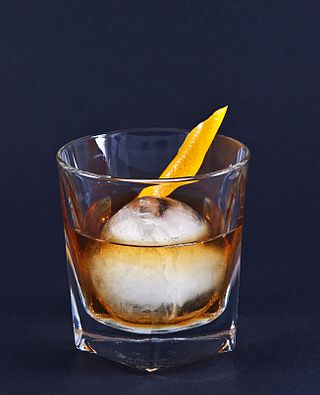
The old fashioned is a cocktail made by muddling sugar with bitters and water, adding whiskey, and garnishing with an orange slice or zest and a cocktail cherry. It is traditionally served with ice in an old fashioned glass.

A margarita is a cocktail consisting of tequila, triple sec, and lime juice. Some margarita recipes include simple syrup as well and are often served with salt on the rim of the glass. Margaritas can be served either shaken with ice, without ice, or blended with ice. Most bars serve margaritas in a stepped-diameter variant of a cocktail glass or champagne coupe called a margarita glass. The margarita is one of the world's most popular cocktails and the most popular tequila-based cocktail.
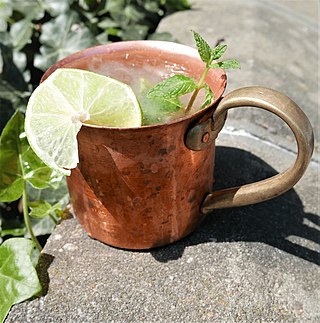
A Moscow mule is a cocktail made with vodka, ginger beer and lime juice, garnished with a slice or wedge of lime, and a sprig of mint. The drink, being a type of buck, is sometimes called vodka buck. It is popularly served in a copper mug, which takes on the cold temperature of the liquid. Some public health advisories recommend copper mugs with a protective coating on the inside and the lip, to reduce the risk of copper toxicity.

A bitters is traditionally an alcoholic preparation flavored with botanical matter for a bitter or bittersweet flavor. Originally, numerous longstanding brands of bitters were developed as patent medicines, but now are sold as digestifs, sometimes with herbal properties, and as cocktail flavorings.

The martini is a cocktail made with gin and vermouth, and garnished with an olive or a lemon twist. Over the years, the martini has become one of the best-known mixed alcoholic beverages. A popular variation, the vodka martini, uses vodka instead of gin for the cocktail's base spirit.

The Singapore sling is a gin-based sling cocktail from Singapore. This long drink was developed sometime before 1915 by Ngiam Tong Boon, a bartender at the Long Bar in Raffles Hotel, Singapore. It was initially called the gin sling.
Pink gin was historically used to reference a type of cocktail made fashionable in England in the mid-19th century, consisting of Plymouth gin and a dash of Angostura bitters, a dark red bitters that makes the whole drink pinkish. In recent years, the term Pink gin has also been used to define a specific category of gin where a range of fruits and flavourings are infused into the gin to give it a pink color.

Lemonade is a sweetened lemon-flavored drink.
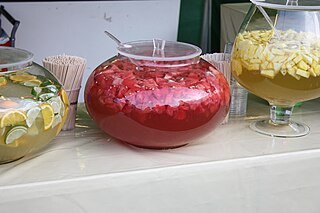
The term punch refers to a wide assortment of drinks, both non-alcoholic and alcoholic, generally containing fruits or fruit juice. The drink was introduced from the Indian subcontinent to England by employees of the East India Company in the late 17th century. Punch is usually served at parties in large, wide bowls, known as punch bowls.

The negroni is a cocktail, made of equal parts gin, vermouth rosso, and Campari, generally served on the rocks, and commonly garnished with an orange slice or orange peel. It is considered an apéritif.

A sour is a traditional family of mixed drinks. Sours belong to one of the old families of original cocktails and are described by Jerry Thomas in his 1862 book How to Mix Drinks.
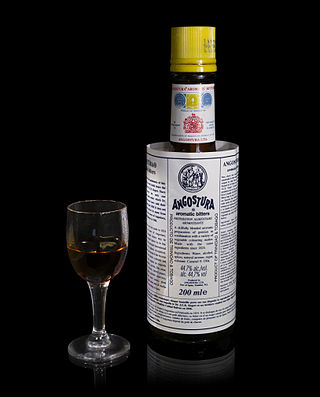
Angostura bitters is a concentrated bitters based on gentian, herbs, and spices, produced by House of Angostura in Trinidad and Tobago. It is typically used for flavouring beverages, or less often, food. The bitters were first produced in the town of Angostura, hence the name, but do not contain angostura bark. The bottle is recognisable by its distinctive oversized label. Angostura is Spanish for "narrowing", the town of Angostura having been at the first narrowing of the Orinoco River.

The Fine Art of Mixing Drinks is a book about cocktails by David A. Embury, first published in 1948. The book is noteworthy for its witty, highly opinionated and conversational tone, as well as its categorization of cocktails into two main types: aromatic and sour; its categorization of ingredients into three categories: the base, modifying agents, and special flavorings and coloring agents; and its 1:2:8 ratio for sour type cocktails.

The Pimm's cup is a cocktail that is popular in England, in the United Kingdom. It is one of numerous fruit cups, a type of cocktail with gin, a soft drink, and fruit. Its primary spirit is Pimm's No. 1 Cup, a gin-based beverage flavored with fruits and spices invented around 1823 as a health drink.
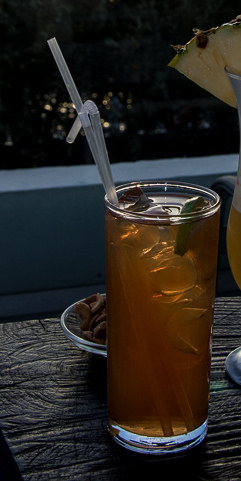
The brandy sour is a mixed alcoholic cocktail considered the unofficial national cocktail of Cyprus. While other forms of the brandy sour cocktail exist, the Cypriot variety is a distinct mixture, which only shares the basic brandy and lemon flavourings with other variants. Both brandy and lemons are among Cyprus's major exports, and both have distinctive Cypriot characteristics.
A long vodka is a vodka-based cocktail, popular throughout Scotland and known to be served in some parts of England.
















